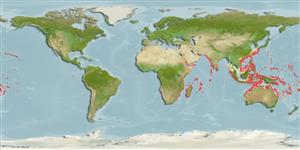Classification / Names
Common names from other countries
Main reference
Size / Weight / Age
Max length : 90.0 cm TL male/unsexed; (Ref. 2871); common length : 60.0 cm TL male/unsexed; (Ref. 9137); max. published weight: 6.7 kg (Ref. 40637)
Environment
Marine; reef-associated; non-migratory; depth range 80 - 370 m (Ref. 5222)
Climate / Range
Tropical, preferred 28°C (Ref. 107945); 31°N - 33°S, 30°E - 158°W (Ref. 5222)
Distribution
Indo-Pacific: Red Sea and East Africa to the central Pacific. Epinephelus poecilonotus, Epinephelus radiatus, and Epinephelus tuamotoensis are sometimes referred to as this species.
Countries | FAO areas | Ecosystems | Occurrences | Introductions
Short description
Dorsal
spines
(total): 11;
Dorsal
soft rays
(total): 14-15;
Anal
spines: 3;
Anal
soft rays: 7 - 8. Distinguished by the following characteristics: head and body tan, with dark brown bands: bifurcate band that begins at rear edge of eye, upper branch extending to a dark brown saddle blotch on the nape just in front of dorsal fin, lower branch running to lower opercular spine and continuing on body as midlateral band that bifurcates above the pectoral fin, upper branch of this band running to a dark blotch at the base of 3rd to 7th dorsal fin rays; dark band from the upper edge of the operculum to base of 5th to 9th dorsal fin spines; narrow band from lower edge of eye to pectoral fin base, continued as broken band along lower part of body and curving up to the dorsal part of peduncle; broad band from maxillary groove to posterior end of interopercle; small dark brown spots often present in the pale areas between bands; depth of body contained 2.8-3.1 times in SL; head length 2.3-2.5 times in SL; flat to moderately convex interorbital area, dorsal head profile slightly convex; shallow indentation on preopercle just above the enlarged serrae at the angle; upper edge of operculum almost straight; maxilla reaches to or past vertical at rear edge of eye; 2 rows of teeth on midlateral part of lower jaw (Ref. 89707).
IUCN Red List Status (Ref. 115185)
Threat to humans
Reports of ciguatera poisoning (Ref. 5222)
Human uses
Fisheries: minor commercial; gamefish: yes
More information
ReferencesAquacultureAquaculture profileStrainsGeneticsAllele frequenciesHeritabilityDiseasesProcessingMass conversion
Tools
Special reports
Download XML
Internet sources
Estimates of some properties based on models
Phylogenetic diversity index
PD50 = 0.5000 many relatives (e.g. carps) 0.5 - 2.0 few relatives (e.g. lungfishes)
Trophic Level
4.0 ±0.65 se; Based on food items.
Resilience
Medium, minimum population doubling time 1.4 - 4.4 years (Preliminary K or Fecundity.)
Vulnerability
Moderate vulnerability (43 of 100)
Price category
